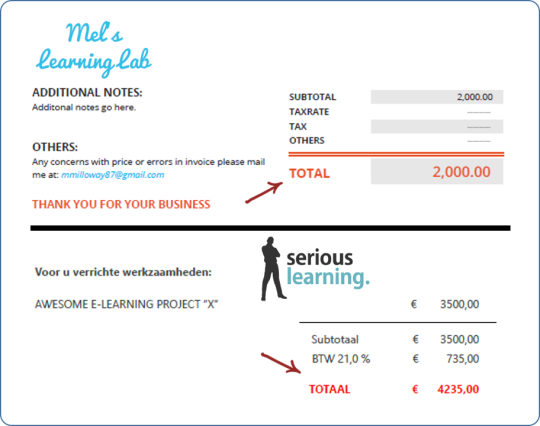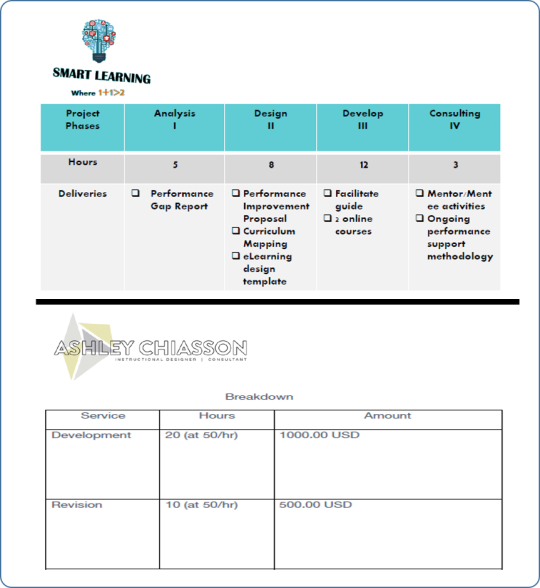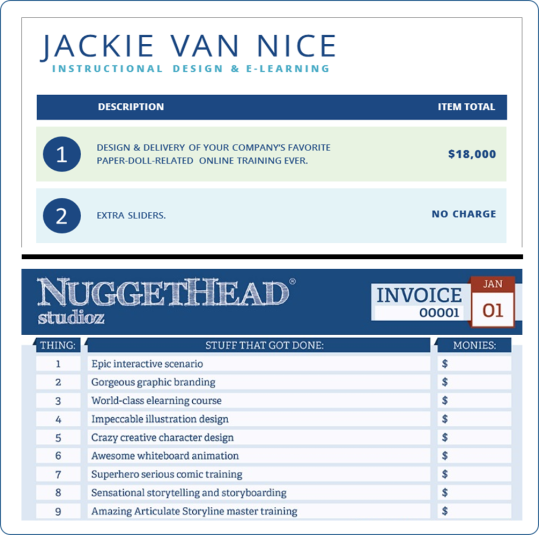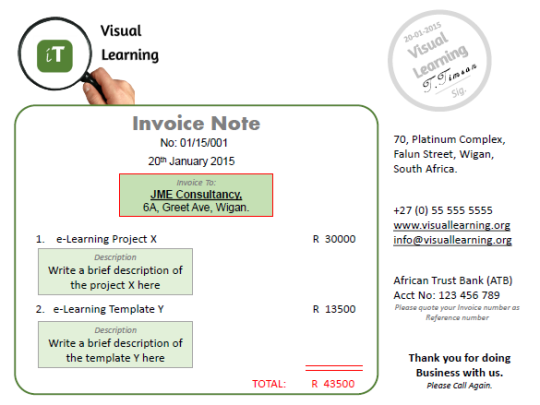This week’s articulate challenge was to design a creative invoice for use in e-Learning. It was a good challenge because sometimes designers become too engrossed in designing and delivering, that we don’t pay enough attention to how to properly prepare an invoice for our work. This challenge called forth several creative ideas from articulate community members and it was an awesome week and invoice-full too.
Many times clients are very eager to give you the scope of the project, what exactly they want and how they want it and what detail must be included; unfortunately when it comes to receiving bills and paying them, there could be some stories. I noticed how course designers designed their invoices to present a convincing bill and aid a happy and speedy payment for their work.
So these three approaches to the design of a convincing and happy Invoice can be adopted:
1. Total-in-red method
As the name suggests, in this method the total cost to be paid is written or displayed in Red. This pulls attraction to it and leaves the client in no doubt of how much exactly he is expected to pay. This makes for a speedier payment. I found this to be one of the commonest methods of presenting the final amount to be paid and as simple as it looks, it works! See Melissa Milloway and Jeff Kortenbosch’s invoices as they both use it.

2. Describe-the-process method
Another approach is to depend on the process of your overall work. Apart from the fact that some clients specifically asks for this, a deliberate breakdown of the entire process helps to convince the client of your work. You could include details like different phases (Scripting, Storyboarding, Resource gathering, design etc), time put in for each phase (and hourly rate), deliverables of each phase and the likes. Clients sometimes don’t know what is put into our work, letting them into what goes into their project encourages a convincing invoice. See Sophia Xu and Ashley Chiasson’s invoices as they display this.

3. Say-its-good method
The final approach I saw is this say-its-good method. Here, you gently describe the success of your work and it’s importance to the client. This can be done in a few ways… Simply say something like “I’ve done an excellent work for you” or “This will be your favorite training course ever”. Another way is to show you have granted discounts for a loyal customer or show there are some extra features or interactions at no cost. The key factor here is to ‘show’ what you did when you actually do it! This makes for a happy customer and Happy payment as well. See Jackie Van Nice and Kevin Thorn use it in their invoices.

Did you see these in these invoices?
And my design?
Oftentimes in large organizations, the final approval for release of funds to pay for a training course is not the training manager but the finance manager, who may not understand why a single project should cost say $20,000; so I decided to include a brief description of what the project was and maybe a deliverable is mentioned there. Also, I displayed my total cost in red.

And how about a combination of two or all three of the approaches? I see quite a number of such designs with more than one, mine is as well! What about yours? What other approach or technique have you used in the design of your invoice and what strategy/policy have put in place that encourages a happy and speedy payment?

That’s a helpful write-up on invoice types, Daniel. I never considered categorizing the different styles but it’s a smart idea!
Thanks again for all you share and contribute, Daniel!
Thanks David for always inspiring these great challenges, you’re definitely in the books of my professional journey!
And thanks to others who also continuously share their great work in the community, I learn a lot from them all!
Great post, Daniel! Thank you for the shout-out!